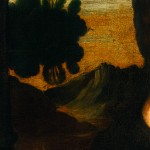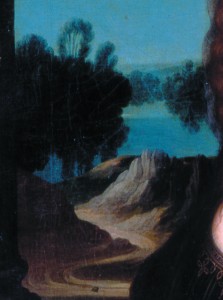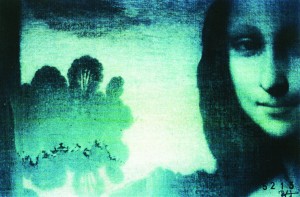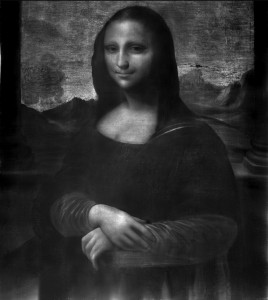Sfumato
The word ‘sfumato’ is derived from the Italian ‘sfumare’ – ‘to evaporate like smoke’, or ‘to tone down’. In art, it is used to denote a painting technique whereby outlines are blurred and there is a gradual blending of one tone into another. This technique is exemplified in the two versions of Mona Lisa.
“The supreme expression of the science of painting and of its divine character, Leonardo’s ‘sfumato’ was the power behind the poetry of his paintings and the mystery that seems to emanate from them.”
The Craquelure
The painting is covered in a series of fine cracks, known as craquelure. This is not only common with old paintings, but would be unusual if it were not present. Paint on old paintings often cracks due to movement of the ground preparation away from the canvas support, a process that naturally occurs over centuries. A similar effect occurs with paintings on wood panels. This craquelure is not the result of any external pressure, was not provoked artificially, and did not occur due to any imperfections in the paint or the ground. There are some later cracks due to stresses over time with the paint film. It has been confirmed that early cracks seen on the X-ray imaging correspond to those visible on the surface.
In-depth studies of craquelure will show up even the finest and most expert restoration work, as the restorer tries to recreate the craquelure threads to be compatible with the surrounding surface that he has disturbed. Intense magnification will invariably identify where the match is not perfect.
The remarkably well-preserved state of the untouched natural craquelure on the surface of the ‘Earlier Mona Lisa’ was first pointed out by Dr. Seracini, and applauded by experts whose examinations followed. Indeed, very little restoration has been attempted on the painting throughout the centuries (in contrast to its Louvre sister), and those minimal restorations have only been located in peripheral and background areas.
Retouches
An in-depth examination of the entire painting was carried out in 2011. Results showed that some minor restoration work to the paint surface of the background took place in the 20th Century, likely between 1926 and 1966. The retouching did not involve any of the important areas or sections such as the figure, hands or lower columns, but fortunately was concentrated in some areas of the sky above the trees, and on the right-hand side above the faded hills. During those procedures, it seems that some definition in the distant landscape was reduced due to possible over-cleaning.

The tree to the viewer’s left appears as if falsely enlarged due to the fading of the blue lake beneath it, on which it was originally reflected.

The copy of ‘Mona Lisa’ from the National Museum, Oslo, shows the original lake and tree reflection as astutely copied by the artist.
Ultraviolet Light Examination
Prior to the recent introduction of such sophisticated technology as ultra-high resolution multi-spectral cameras, the ‘Earlier Mona Lisa’ underwent numerous traditional procedures. Ultraviolet photography can be used to observe the coloured fluorescence characteristics of the pigments in the paint, and can help to identify them or differentiate between them. Any efficiency in ultraviolet light illumination will depend upon the phenomenon known as fluorescence that occurs on the surface of the painting.

Detail – Ultraviolet light examination.
Regarding the background, there are two areas on the left of the painting, and various smaller areas on the right, that fluoresce less than the adjacent paint. This could indicate some slight retouching or restoration to the original paintwork in those areas. In addition, some parts that appear slightly hazy in the fluorescence indicate the possibility that additional varnish may have been applied over the retouched spots. A subsequent scientific analysis of the pigments in 2005 verified that some areas of the painting carried more varnish than others.
Infrared Luminescence
The photographic results of the infrared luminescence examination penetrate just the upper surface layers, varnish in particular, for the purpose of making observations below these layers. Though the penetration is only partial, this process has the use of verifying observations made by ultraviolet fluorescence. With respect to this painting, there were no abnormalities other than the minor inconsistencies previously mentioned.
Infrared
Infrared light is electromagnetic radiation with a wavelength longer than that of visible light. Infrared has the advantage of being able to penetrate deeper than ultra violet light and infrared luminescence. However, the results can only be studied photographically. Since infrared photography records only near infrared, the possibility of penetrating the pigments at these wavelengths is limited, which means that while thin, fairly light colours become transparent, certain other colours such as dark blues and greens based on copper pigments remain opaque. In the case of this Mona Lisa, the usual surface layers correspond to the infrared image.
False Colour Infrared
First introduced in 1910, false-colour imaging is today observed on a computer. The photograph in direct light, composed of red, blue, and green layers, is mixed with the infrared image. To achieve this, the blue layer is removed, and the three remaining layers are divided up as follows: the infrared becomes the red layer, the red image replaces the green layer, and the green image replaces the blue one. Often an ‘infrared filter’ is used: this lets infrared light pass through to the camera, but blocks all or most of the visible light spectrum.
The result provides information about the nature of the pigments used, and makes it easier to locate the changes, if any, made to the composition by the painter. The various analyses undertaken on the painting report that no changes were made to the composition.
Infrared Reflectography

Infrared Reflectography. This process can assist in revealing underdrawings, and in a recent test on the ‘Earlier Mona Lisa‘, provided information about the materials used and techniques employed.
This is a non-destructive process, pioneered in the 1950s, which is popular for analysing underdrawings in paintings. Based on the same principle as regular infrared photography, and using a slightly different system of detection, it is sensitive up to 2000 nanometers, making it possible to penetrate some opaque pigments. This method of examination is essential for studying a painting’s underdrawing if any, and can also provide information about the materials used (dry and fluid), the instruments and techniques employed, the development of the drawing, if any, as, for example, places where the original composition may have been altered or abandoned.
An examination in 2010 by Pascal Cotte did reveal clear underdrawings, and confirming it as an as an original painting.
X-Ray Examination

X-Radiography. A 2005 X-ray procedure on the ‘Earlier Mona Lisa‘, revealed the sequence in which the painting was executed; the figure, the columns, the sky, and then the landscape. This X-ray image also shows the stretcher behind the canvas, and the nails used to secure the canvas to it.
X-rays are absorbed by the white that contains lead and other dense pigments. They do not reveal pigments not containing lead, but they do show the sum of dense paint of all the superimposed layers. In an early examination of the painting, no other image was discernible below the surface image. In fact, the X-ray plates showed almost all the surface details, including the figure, the balustrade, and the columns with the bases. Only the background was not present, likely due to the amount of lead white.
In a later 2005 examination the X-radiography revealed the order in which the painting was executed. First the figure and columns, then the sky, and finally, the landscape. In an X-radiography detail of the head, the barely radiopaque materials used to paint the hair were outlined by the more radiopaque materials used in the sky.
2010 Multispectral Examination
Pascal Cotte of Lumiere Technologies in Paris conducted extensive spectral analyses of the painting using cutting edge equipment and methods that have been used to examine the Louvre ‘Mona Lisa’ and other Leonardo paintings, as well as to authenticate recent attributions to the master.

The multispectral imaging process revealed definite areas of underdrawing, as indicated by the white outlines above.
A summary of the 2010 results of the analyses conducted on the ‘Earlier Mona Lisa’ are:
• All pigments used were common on Leonardo’s palette, and were available at the beginning of the 16th Century in Florence.
• The painting has some clear underdrawings, by the columns and elsewhere, signifying that it is not a direct copy of anything, and clearly an original work.
• No handprint or fingerprint could be identified; a similar result as that for the Louvre ‘Mona Lisa’.
• No traces were found of the glazing techniques developed only later by Leonardo during his ‘Second Milanese Period’ (1506-13). [The earliest known use of these techniques can be found in his famous cartoon: ‘The Foetus in the Womb’ c.1510. The Louvre version, by contrast, displays them, especially to demonstrate shadows and give the appearance of a three-dimensional effect to the eye]
• The lady’s right elbow is resting on the arm of the chair, below which are very fine details, similar to the Louvre version that cannot be seen by the naked eye and likely only known to the artist. Mr. Cotte confirms that the artist was likely the same for both paintings.
• Apart from obvious differences with the Louvre version, such as the columns, and the ages of the sitters, there are clearly many other small variations in what may appear at first glance to be the same: the embroidery knots, the sleeves, etc. This removes any doubt that either painting could have been a copy of the other.
Mr. Cotte confirmed that the scientific analysis undertaken with the Lumiere Technology multispectral camera fails to show any result that could indicate that the ‘Earlier Mona Lisa’ was not painted by Leonardo. In a 2015 Documentary aired on PBS in the United States, Mr. Cotte stated the following concerning the ‘Earlier Mona Lisa’: “If we analyse the pigments, all the pigments are OK. So the Carbon dating is OK. The varnish is OK. The binder is OK. So technically, everything is OK.”
*Editor’s note: In December 2015, it was reported that Cotte had found a hidden portrait underneath the surface of the painting using reflective light technology. The portrait was claimed to be an underlying image of a model looking off to the side. Having been given access to the painting by Louvre in 2004, Cotte spent ten years using layer amplification methods to study the painting. According to Cotte, the underlying image may be Leonardo’s original Mona Lisa. However, Cotte himself admits this is only a hypothesis, and the majority of experts oppose this idea.